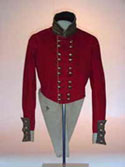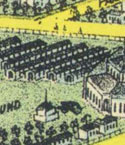 Early in 1838, elements of the 32nd Regiment of the British Army marched into London inaugurating the British Army's stay in the city that would last, on and off, for about 30 years. A huge block of land north-east of the settlement was reserved for the barracks, bounded roughly by Richmond, Dufferin, Waterloo and Piccadilly. A frame barracks was constructed on what is now Victoria Park and a barracks for the Royal Artillery was located on the site of the present city hall. Early in 1838, elements of the 32nd Regiment of the British Army marched into London inaugurating the British Army's stay in the city that would last, on and off, for about 30 years. A huge block of land north-east of the settlement was reserved for the barracks, bounded roughly by Richmond, Dufferin, Waterloo and Piccadilly. A frame barracks was constructed on what is now Victoria Park and a barracks for the Royal Artillery was located on the site of the present city hall.
Following the last Patriot attack, late in 1838, there wasn't much for the troops to do except drill and occasionally entertain themselves in town. The arrival of the garrison, which usually numbered about 500 men, might have been part of the reason that both Thomas Carling and John K. Labatt left their nearby farms to come to town and engage in brewing beer in the 1840s.  Other opportunities for the army to contribute to the local economy came from building, maintaining and heating the barracks, feeding the troops and their horses, and mending and replacing uniforms and equipment such as harness and weaponry.
Other opportunities for the army to contribute to the local economy came from building, maintaining and heating the barracks, feeding the troops and their horses, and mending and replacing uniforms and equipment such as harness and weaponry.
The officers, usually the younger sons of English nobility, provided the town with entertainment including steeple chases and theatrical performances, presented in an unfinished church they had converted into a theatre. Sports days at the barracks attracted much public attention as well. Sections of ten regiments were successively stationed at London before 1853 when the garrison was virtually emptied by the Crimean War.  The troops returned in 1861 when Britain's relations with the US began to deteriorate. Eight regiments rotated through London between 1861 and 1869, when the last of Britain's soldiers left Canada for good. The troops returned in 1861 when Britain's relations with the US began to deteriorate. Eight regiments rotated through London between 1861 and 1869, when the last of Britain's soldiers left Canada for good.
Not all of the military reserve was utilized by the army. A large exhibit hall, designed by architect and city engineer William Robinson, was built just north of Central Avenue (then Great Market Street) in 1861 for the Provincial Agricultural Exhibition. The hall and the surrounding grounds became the site of the Western Fair starting in 1868 and continuing to 1886, after which the fair was moved to Queens Park.
In 1887 some of the lands were subdivided, leaving the park, as well as a large parcel east of Wellington and south of Central, which was used by the militia until the new Armouries was built in 1905. The CPR was built through the north end of the reserve in the 1880s.

|